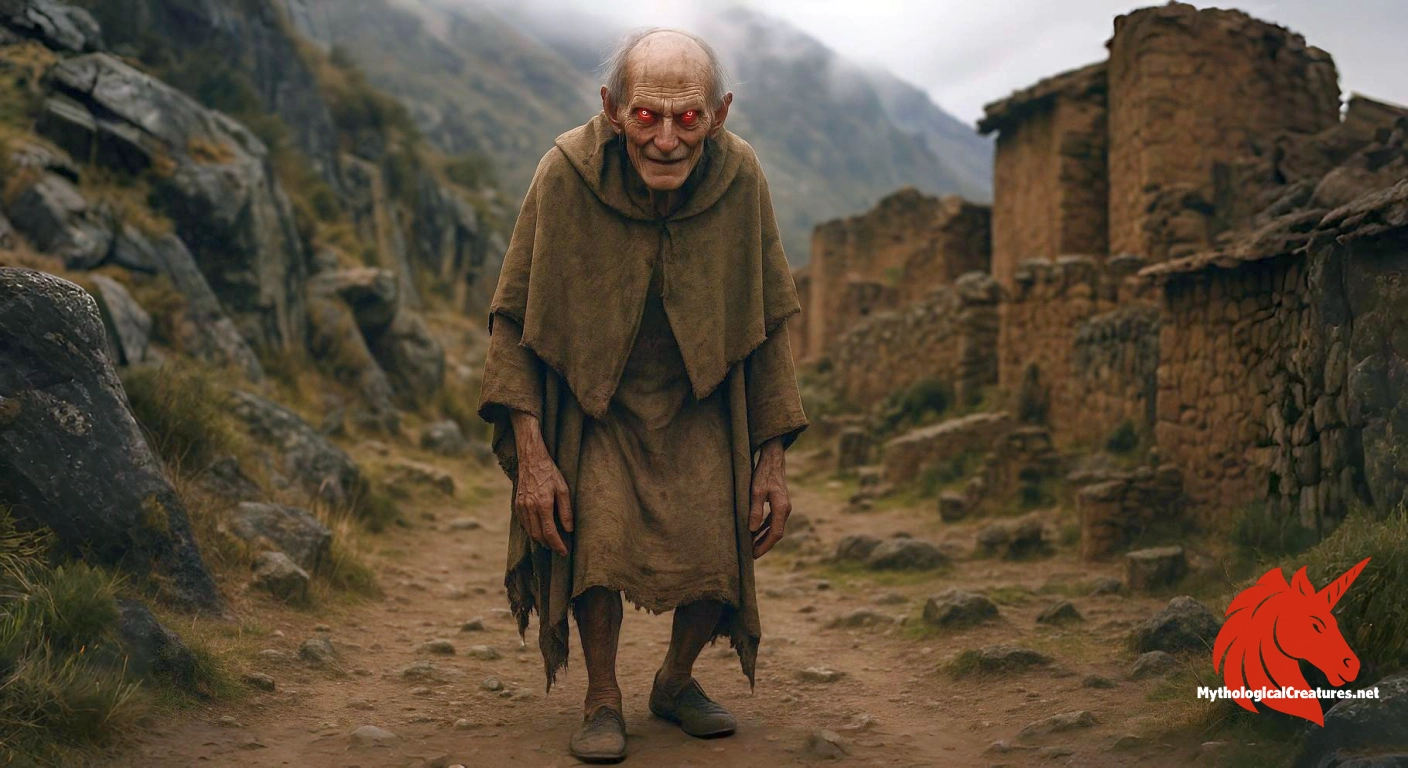Abchanchu: Abchanchu is a legendary Bolivian vampire known for his deceptive ability to shapeshift into a harmless, elderly traveler.

Abchanchu
Abchanchu - Serves as a warning against misplaced charity, embodying deception and the dangers lurking in seemingly harmless individuals
Origins & First Encounters
Abchanchu stands as a captivating figure within Bolivian myth, a being whose legend is woven from the threads of indigenous mysticism and colonial influences. His story is steeped in local tradition, where he appears as a seemingly vulnerable elderly traveller, inviting unsuspected goodwill before revealing his true, predatory nature. Long passed down through generations, his myth resonates with themes of deception and the dangers of misplaced compassion. The character’s origins appear to lie in the rich oral traditions of rural communities, where each retelling adds layers of complexity and symbolic meaning. His guise as the feeble, aged wanderer subverts expectations, challenging the viewer to question the surface appearance of truth and benevolence. The narrative often warns of the trepidation hidden behind the mask of frailty, a lesson in the potential perils of unchecked trust. Regional storytellers have enriched his identity with nuances that reflect local fears and moral lessons. Today, Abchanchu epitomises the convergence of vulnerability and menace, a timeless reminder of the dangers that dwell in the shadows of society.
Source Texts & Tale Variants
Accounts of Abchanchu emerge primarily from the vibrant oral traditions of Bolivian folklore, reflecting a tapestry of local narratives that span centuries. Although he is not extensively covered in classical historical texts, dedicated folklorists have gathered various accounts from remote communities that recount his cunning exploits. Early records, preserved in local annals and recounted by village elders, hint at encounters with this shape-shifting vampire. Some versions of the tale focus on his deceptive acts as he approaches innocent passersby under the guise of weakness, while others delve into more elaborate backstories that interweave indigenous spirituality with vampiric menace. Variations of the legend differ in the specifics of his transformation and the particular circumstances under which he preys on his victims. Many local storytellers introduce subtle differences in his modus operandi, reflecting the dynamic nature of oral transmission. As these narratives were passed down through generations, each retelling subtly transformed his character for the contemporary listener. Modern compilations of folklore have begun to piece these disparate accounts together, offering a glimpse into a multifaceted myth that continues to evolve.
Form & Powers
In most depictions, Abchanchu appears as a feeble, elderly man with remarkable ability to transform his physical form. His visage is commonly described as pallid and lined with deep wrinkles, a testament to both his assumed age and the weight of many untold sorrows. The details often evoke an unsettling presence, where a pair of eyes may sometimes seem to flicker with a hidden, predatory gleam. His appearance may exhibit an almost spectral glow under certain lights, hinting at his otherworldly nature. Observers recount that even in his frailty, there lies an unexpected strength, as if his corrupted energy defies natural limitations. Some tales emphasise the presence of sharp, predatory features, occasionally revealing glimpses of unnaturally pronounced fangs beneath a weathered smile. The creature’s physical ensemble sometimes includes a tattered cloak and a dishevelled beard, reinforcing the image of a weary traveller. Yet the true horror of his physique emerges when his facade briefly gives way to an unmistakable aura of menace, aligning with his bloodthirsty appetite. These striking contrasts create a visual narrative in which apparent vulnerability conceals lethal danger, adding depth to his mythic persona.
Regional Faces
The myth of Abchanchu adapts and transforms as it traverses different regions of Bolivia, reflecting the diverse cultural landscapes of the area. In the highland Andean villages, the creature is often portrayed as a spectral figure whose eerie presence warns of hidden dangers on remote mountain trails. Some rural accounts depict him with an added layer of mysticism, blending indigenous spiritual elements with the traits of a classic vampire. In contrast, communities in the lower altitudes sometimes entwine his legend with stories of river spirits or forest apparitions, broadening his influence beyond a single archetype. Local rituals and protective charms unique to these regions often play a significant role in the legend, suggesting various methods of warding him off. Though his core narrative of deception remains consistent, the nuances in local descriptions highlight differences in cultural attitudes towards supernatural forces. Varying interpretations may also include subtle regional shifts in his backstory, sometimes imbuing him with tragic motivations or a redemptive quality. These regional adaptations underscore the fluidity of folklore, with each local retelling adding its unique cultural imprint to the enduring myth of Abchanchu.
Cultural Parallels
The figure of Abchanchu draws intriguing parallels with vampiric and shapeshifting legends found in other parts of the world, underscoring common human fears and the allure of the unknown. His method of disguising himself as a harmless, aged traveller resembles European vampire tropes, where the deceptive appearance often belies a more sinister reality. Similar to other Latin American legends, such as those of spectral tricksters and bloodthirsty entities, his myth serves as a moral and cautionary tale about the dangers of misplaced trust. In broader cultural comparisons, Abchanchu can be likened to figures in various global mythologies who assume benign façades to prey upon the unsuspecting. His dual nature as both a seemingly weak individual and a formidable predator resonates with common archetypes found in folk narratives worldwide. The blending of indigenous beliefs with imported ideas of vampirism not only enriches his character but also forms a bridge between disparate cultural myth systems. This cross-cultural phenomenon highlights how similar themes of deception and danger emerge in isolated communities across the globe. Through such analyses, Abchanchu is seen not merely as an isolated legend but as part of a wider pattern of myth-making, where fear and caution are embedded into the fabric of storytelling.
Legacy & Modern Evolution
Over successive generations, the myth of Abchanchu has undergone significant transformation, adapting to the shifting cultural landscape of Bolivia and beyond. Initially circulating as a local warning tale passed down through oral tradition, his legend has grown in complexity and reach with each retelling. Modern reinterpretations have seen him emerge as a potent symbol of the dangers inherent in blind compassion and misplaced trust, themes that continue to resonate in a contemporary world. His image has been reimagined in literature, film, and visual arts, where the interplay between innocence and predation is highlighted through modern narrative techniques. As a cultural icon, Abchanchu now appears in urban legends and creative works as a timeless reminder of the hidden perils that lie beneath seemingly benign surfaces. Contemporary artists and storytellers have drawn on his dualistic nature to explore themes of isolation, transformation, and the corrupting power of deceit. This evolution mirrors broader societal shifts, as traditional myths are recontextualised to address current concerns and anxieties. His enduring legacy reflects not only a connection to the past but also an ongoing dialogue with modern interpretations of horror and morality. The dynamism of his myth ensures that Abchanchu remains a subject of fascination and concern, bridging the gap between ancient lore and modern cultural expressions.
Interesting Fact
Unlike typical vampire legends that evoke Gothic horror, Abchanchu's deceptive transformation into a helpless elderly traveler uniquely underscores the moral lessons embedded in Bolivian folklore.
Mythology commerce, done carefully
Align your store with our global myth audience
If you sell myth-inspired jewellery, prints, decks, or collectibles, we can feature your brand without overwhelming the reading experience.
Partner with usQuick Creature Info
Origin:
Features:
Our Mythic Legendary Rating:

Habitat:
Supernatural Powers:
Physical Attributes:
Abilities:
Behavior:
Weaknesses:
Lore:
Related Creatures, Tales or Lore
- DDracula
- NNosferatu
- CChupacabra
References
Discover Another Mythical Legend You May Not Have Heard Of?
Uncover the mysteries of ancient folklore and expand your knowledge of legendary beings from cultures around the world.
Dare to Meet the Panam Ningthou....
Curated by the Mythological Creatures Team
Series editor: Mythological Creatures Directory
Primary desk: Americas & Indigenous Traditions Desk
(rev. November 2025)
